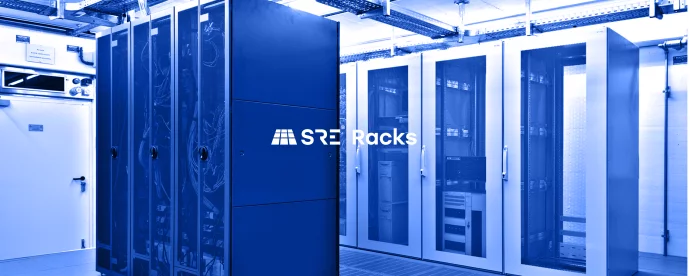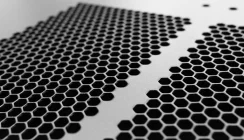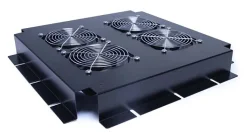Sizing Racks For Your Server Room Design
When it comes to room design, it is vital to ensure you make the right choices in the selection of your server racks and cabinets. There are several topics to consider, all of which can impact the overall layout optimisation, functional efficiency and the future scalability of your room design.
How Many Server Cabinets Are Needed?
The first step when sizing server racks is to list each server and piece of IT equipment that is to be housed within the rack cabinet. This should include not only the rack mounted equipment but any other items that will need their own rack mount shelf.
Against this list it is important to add the U-height and depth. U-height is the standard measure for internal rack heights, with 1U = 1.75inches or 44.45mm. Server rack cabinets are manufactured in a range of U heights from 12U to 47U or more Whilst all IT equipment is available in a 19inch rack mount format, some smaller computer rooms or server rooms may have equipment that needs to sit on a shelf. Knowing the size of 1U in inches or mm also allows the calculation to consider any other tower form hardware to be mounted onto a shelf.
Internal Dimensions : U-Height and Depth
The U-height measures the internal height. If you select a 42U high cabinet, you know that the internal height is 42 × 1.75 = 73.5 inches. If you have twenty 2U servers to house, they would need 20 × 2 × 1.75 = 70 inches and the 42U high cabinet would be enough with 73.5-70 = 3.5inches left over.
For the 3.5inches not used we would suggest a blanking plate to improve air flow and cooling performance as the equipment draws air in through the front of the rack and expels this via the rear panel.
However this sizing does not account for future expansion and scalability. It is therefore important to add a factor of at least 10% to the calculation. Future expansion size required = 20 × 2 × 1.75 = 70 × 110% = 77 inches. In this instance the 42U cabinet would be under sized. The next available size being a 44U high cabinet.
It is also important to select a cabinet that matches the depth required. Most server cabinets have a 500, 800 or 1000mm internal depth. As well as ensuring the rack cabinet can take the servers and IT equipment it is also important to allow additional rear panel depth for cabling and cable curve radius.
In terms of dimensions it is important to ask whether you can receive deliver of your chosen server cabinets as built-up units. The delivery route from goods-in to their final location within your server room or data centre must be wide and tall enough for clearances, with easy access. Otherwise it may be necessary to look at choosing multiple server racks with a smaller U-height to reduce the height and overall cabinet weight or purchasing semi-knock down (SKD) kits requiring on site assembly.
External Appearance : Doors, Security, Panels and Frames
The internal arrangements of a rack cabinet will help to ensure good air flow for cooling and power distribution, access and maintenance. Each piece of IT equipment will require a power source, and most will be AC powered via a cable cord. Provision should be made for an appropriately sized power distribution unit (PDU) which may be basic horizontal format type or a vertical format including meter and smart or intelligent functions such as remote monitoring via SNMP and individual socket outlet power measurements and functional control.
The front of the cabinet may be fitted with a door to secure access using a traditional key, wireless barrel or biometric lock connected to a central access control security system. The choice of door can be a mesh panel or a glass one. Either can carry a logo which for some enterprise and colocation datacentres is an important branding and client identification consideration.
Access for maintenance is also important. Most server racks sit side-by-side and in this instance maintenance panels provide containment for cooling and overall air flow. The panels for end-of-row server cabinets provide access for maintenance. The rear of a server cabinet can also have a door fitted or an access panel or be left exposed to the maintenance aisle.
When a cabinet has a door and panel(s) it is classed as a closed-frame type. Open frames have neither a door nor panels. Open frames provide unrestricted access and may be suitable for certain types of installation where this is not an issue i.e. a secure room. Open frame type cabinets may be 2-post or 4-post.
Open frames cost about one third of a closed frame. There is less metalwork and no door or panel options. The open frame also has unrestricted airflow from all sides, front and rear and is exposed to room ambient temperatures. From a security and control point of view, open frames leave equipment, cables, buttons and breakers exposed. There is a greater chance of theft, damage and accidental disconnection. The open frame also exposes equipment is more dust and debris within the environment which can lead to operational problems, internal fan failures and the potential for static build-up and short-circuits.
Closed-frames provide a far more secure and managed environment for IT servers and equipment. Not only can access be restricted. The air flow can also be managed to prevent life shortening ‘hot-spots’ and potential fire risks. Additional roof top cooling fan assemblies may an option or rear door liquid cooling systems to further improve cabinet cooling and especially within high density cabinets with a power draw of 20-30kW or more. Closed-frames do have a higher cost and weight but are usually the preferred choice for server room and data centre environments.
Summary
Choosing the right rack cabinets relatively straight forward. Rack manufacturers supply their cabinets to standard dimensions (both internal and external) which are industry recognised and there are a few leading brands and more specialist manufacturers catering for high IP-ratings and customisation in terms of rugged cabinets, metalwork and colour choices.


























